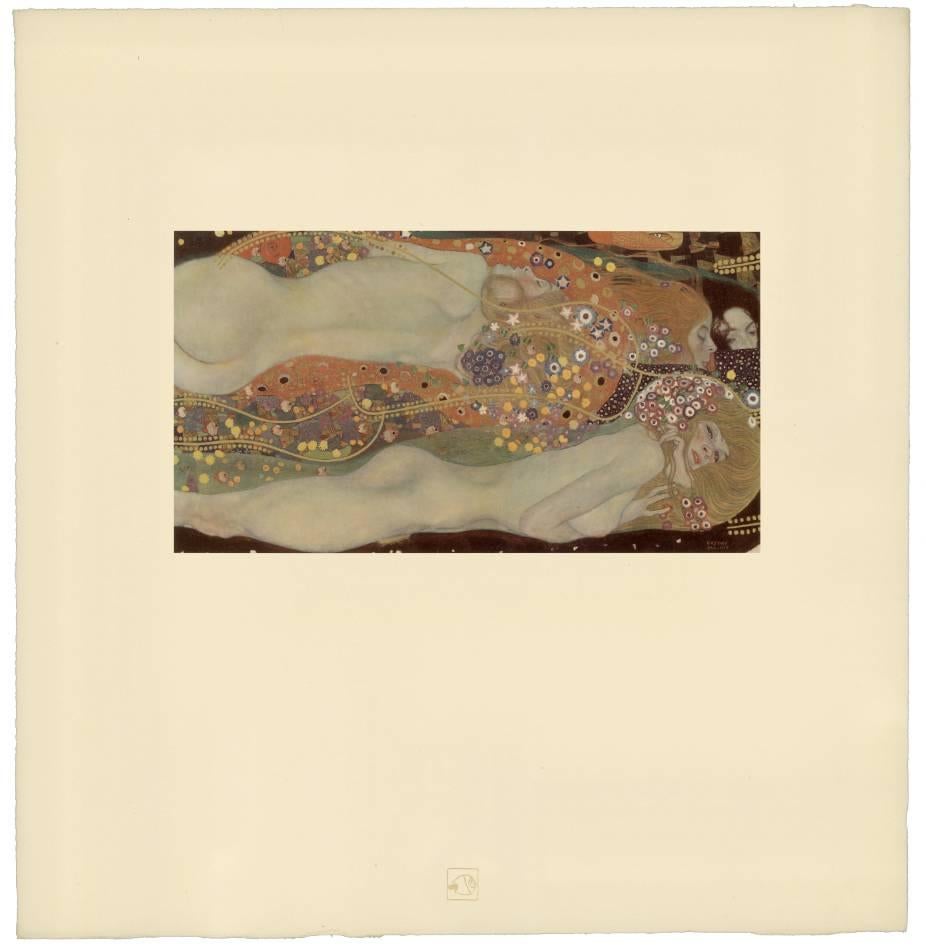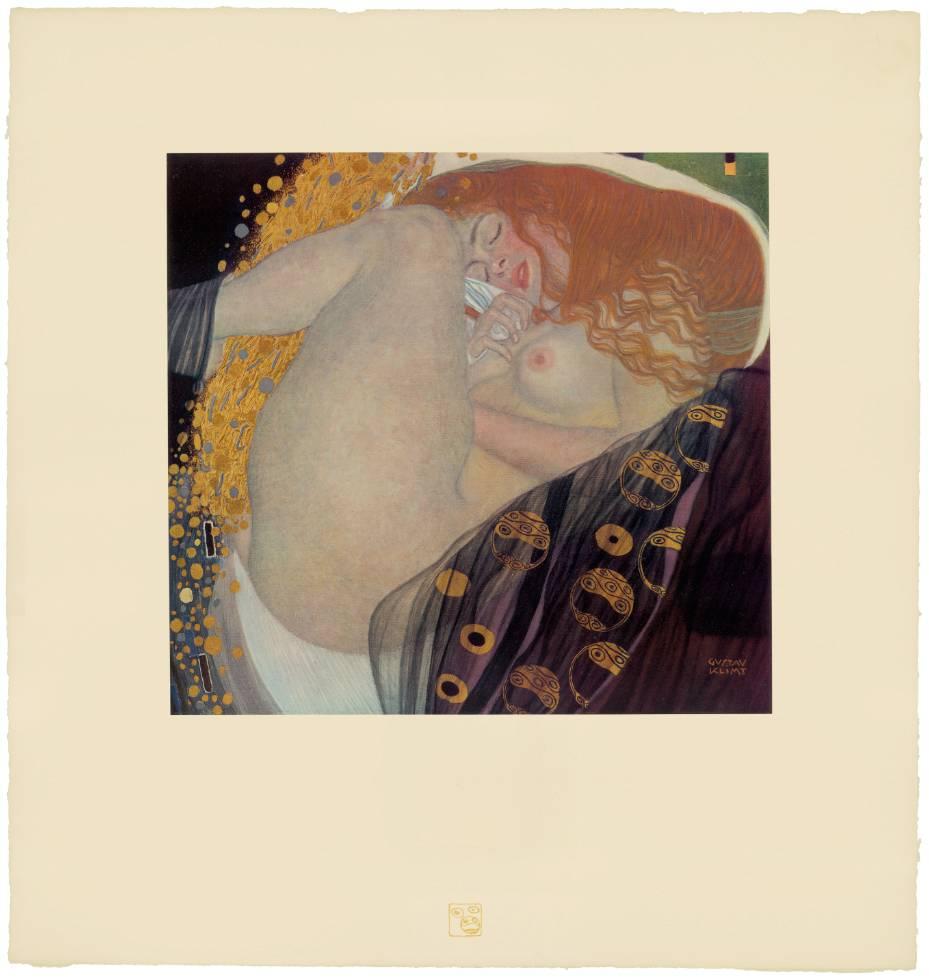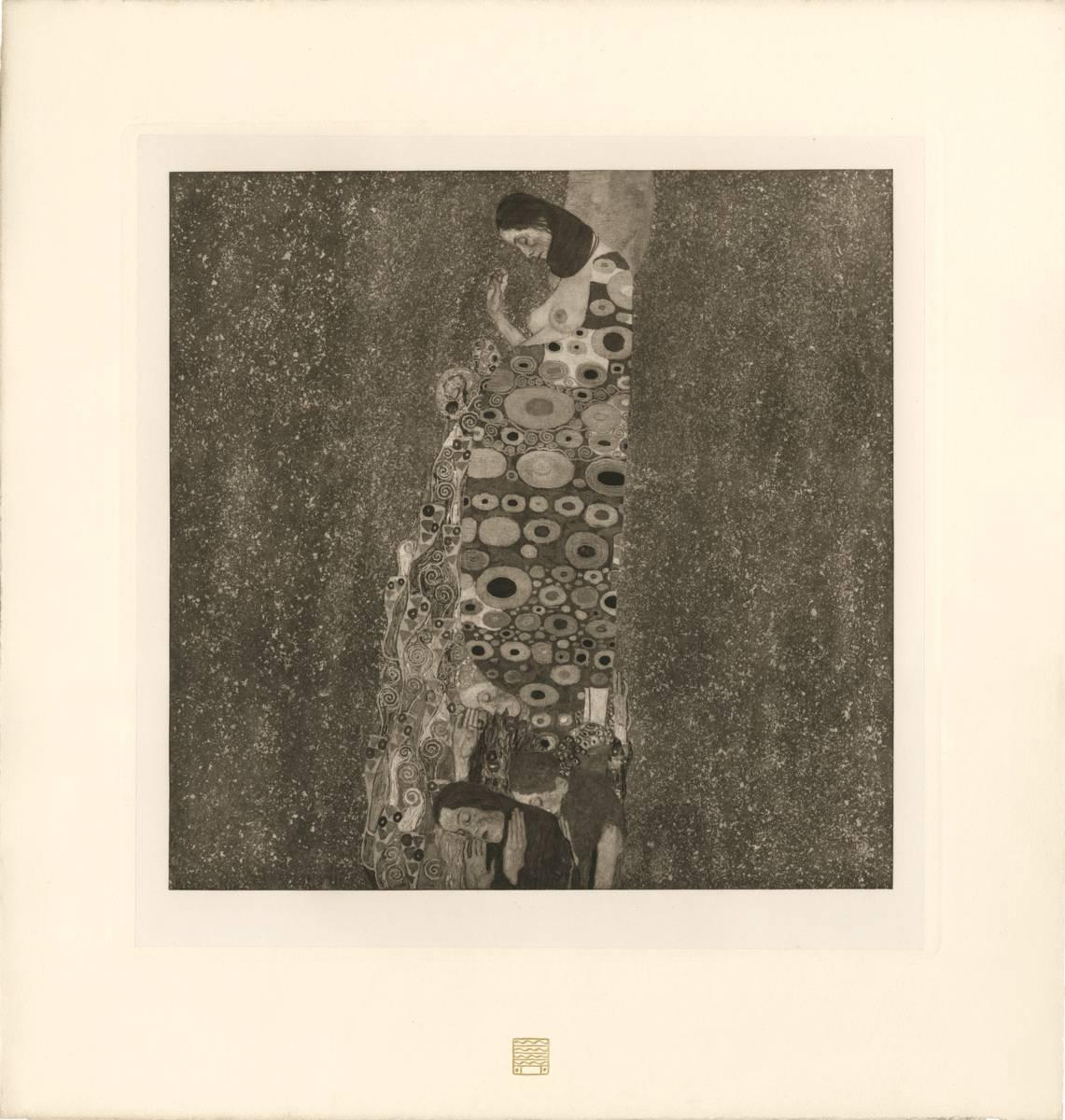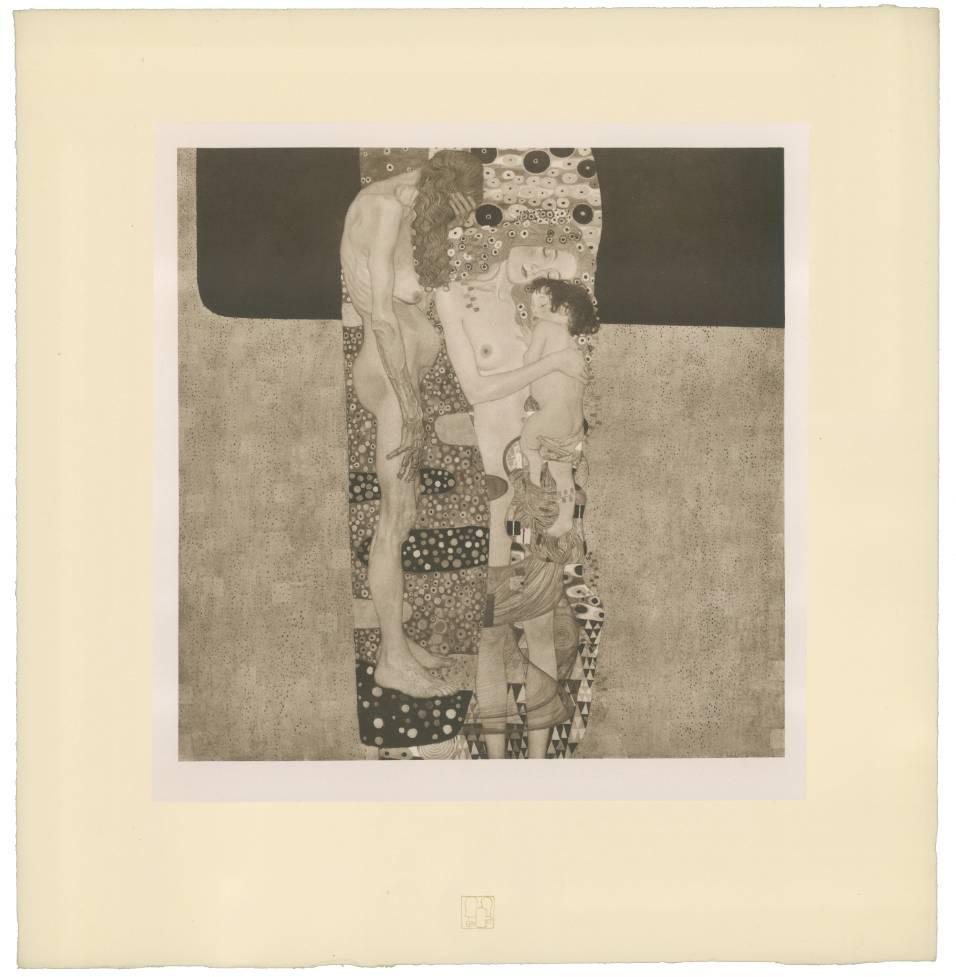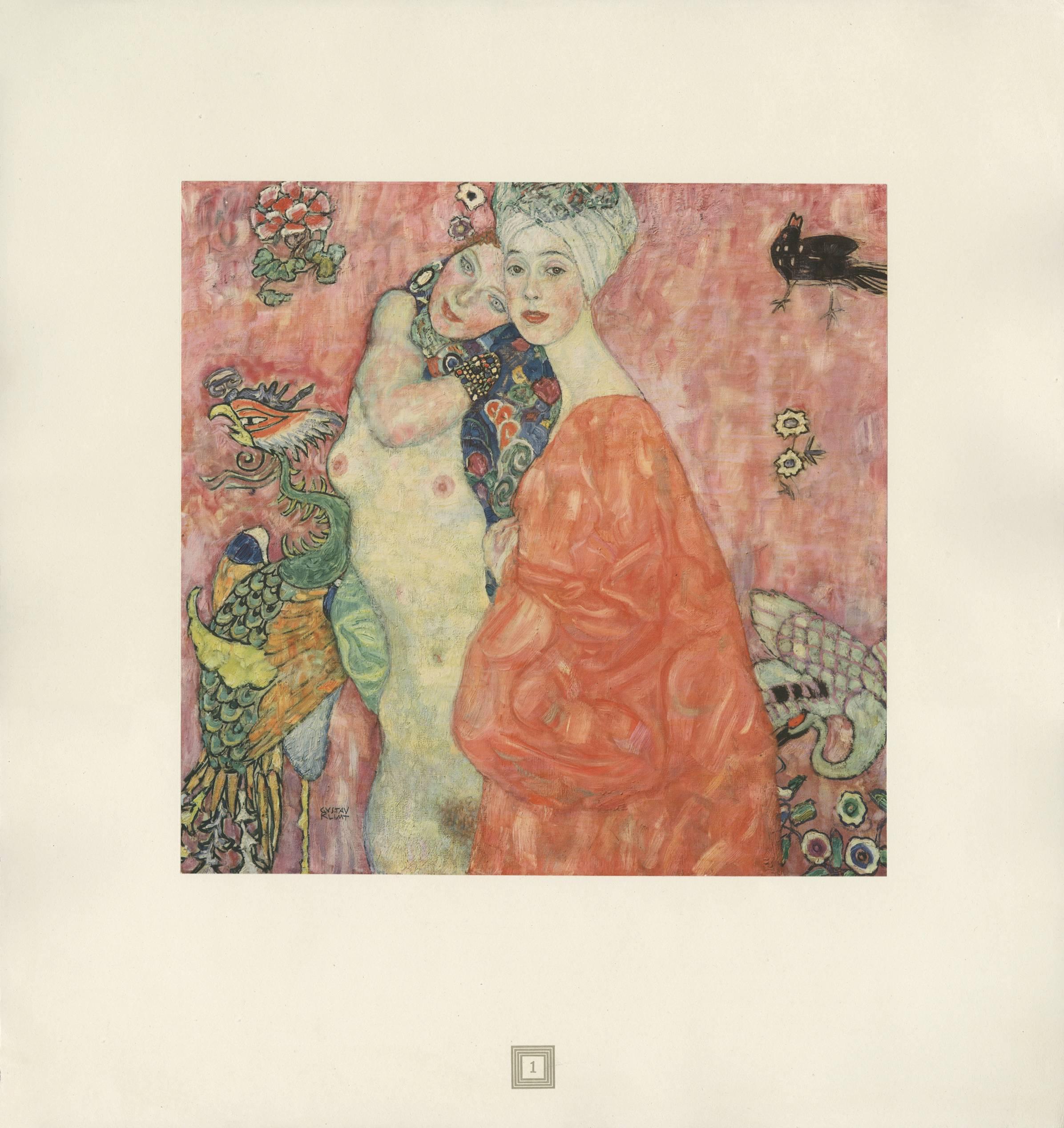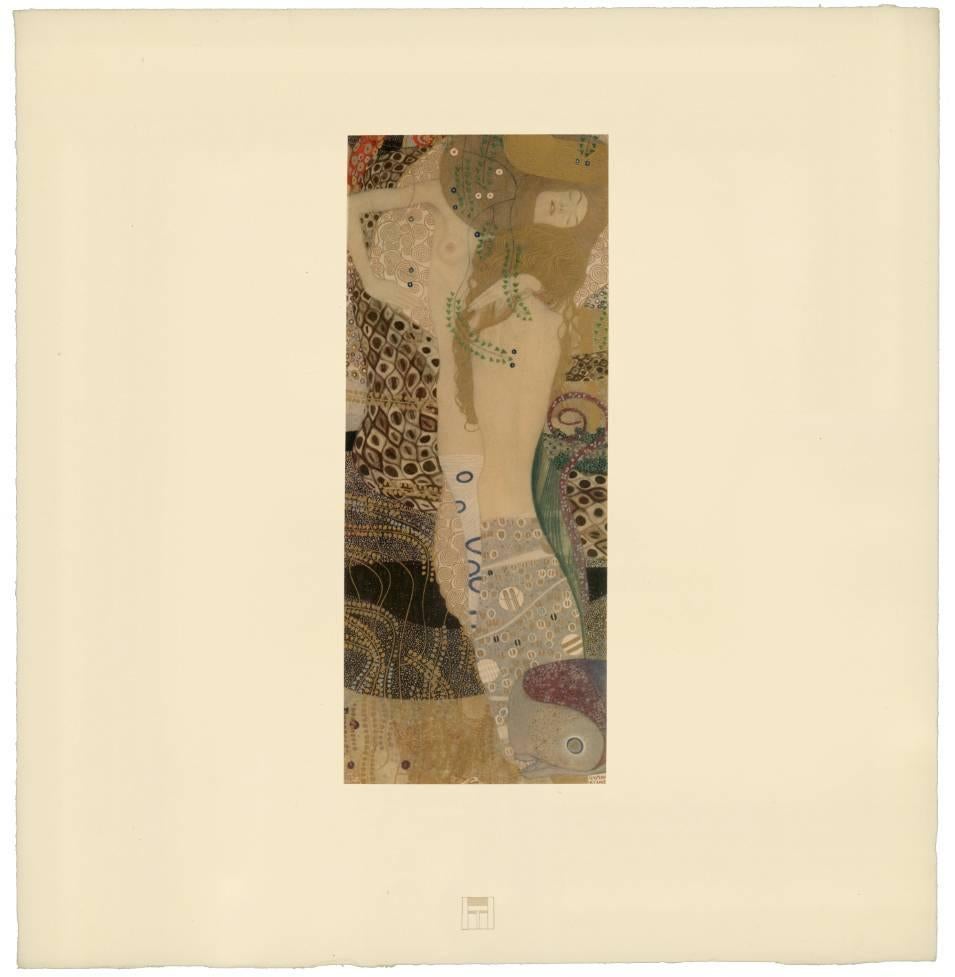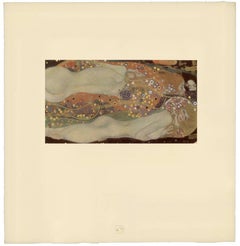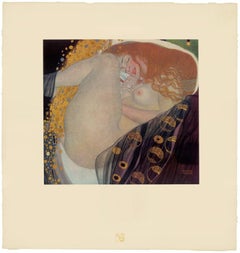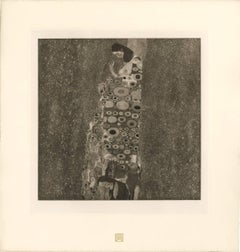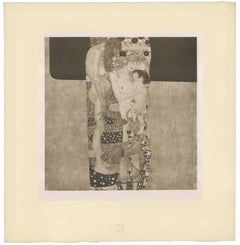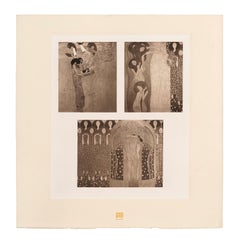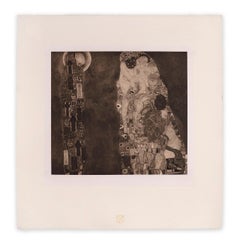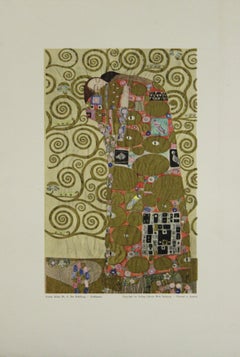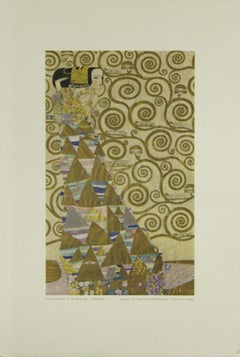Items Similar to H.O. Miethke Das Werk folio "The Virgins" collotype print
Want more images or videos?
Request additional images or videos from the seller
1 of 7
Gustav Klimt & K.K. Hof-und StaatsdruckereiH.O. Miethke Das Werk folio "The Virgins" collotype print1908-1914
1908-1914
$25,000
£18,979.88
€21,750.38
CA$35,484.19
A$38,704.28
CHF 20,332.35
MX$468,242.48
NOK 254,364.36
SEK 240,170.58
DKK 162,351.59
About the Item
The Virgins, no. 2 from the fifth installment of Das Werk Gustav Klimts
The Virgins speaks to a new chapter of Klimt’s artistic development. That it was selected as the final multicolor collotype to be featured in the Das Werk portfolio is a clear demonstration in what high esteem Klimt and the Galerie Miethke held it. After having been thwarted in their efforts to purchase The Kiss in 1908, Czechoslovakia purchased this painting for the National Gallery in Prague in 1914. The work’s circular nature is a multi-layered symbolism. For Klimt, the circle represented the life-cycle to which the feminine is inextricably linked. Through the overall composition of a cluster of females encircling one another and forming one large circle and the individual whorls and small circular flowers which adorn these females, Klimt depicts a moving vortex. Caught up in this powerful current of life, we are all interconnected in a cosmic force. At the center of this composition is the virgin’s womb upon which Klimt has placed a flower encased by a circle of whorls. The gold signet that Klimt designed for this image in the form of a flower like the one at the center of this image is a clue to the significance he placed upon the power of symbolic meaning. The master, for all his artful magic, continued to be in awe of the ageless mysteries of life.
DAS WERK GUSTAV KLIMTS, a portfolio of 50 prints, ten of which are multicolor collotypes on chine colle paper laid down on hand-made heavy cream wove paper with deckled edges; under each of the 50 prints is a gold signet intaglio printed on the cream paper each of which Klimt designed for the publication as unique and relating to its corresponding image; H.O. Miethke, Editor-Publisher; k.k. Hof-und Staatsdruckerei, Printer; printed in a limited edition of 300 numbered plus several presentation copies; Vienna, 1908-1914.
The idea of collaboration in the arts is anything but new; however it has so often been viewed and assessed as somehow devaluing the intrinsic worth of art. It’s as if it was a dirty secret to be hidden away. More so even than the eroticism explored by Klimt, which divided public opinion, the artistic avant-garde began to boldly flaunt artistic collaboration beginning in the 19th century- which gained steam in the first part of the 20th century- to become a driving vehicle of contemporary artistic creation. Viewed in this context, the folios of collotype prints published by H.O. Miethke in Vienna between 1908-1914 known as Das Werk Gustav Klimts, are important art documents worthy of as much consideration for their bold stand they take on established ways of thinking about artistic collaboration as they are for their breathtakingly striking images.
1908 is indeed a watershed moment in the history of art. To coincide with the 60th anniversary of the reign of Emperor Franz Joseph I, Kunstschau opened in Vienna in May of that year. It was there that Klimt delivered the inaugural speech. Speaking about the avant-garde group’s unifying philosophy of Gesamtkunstwerk, or the synthesis of the arts, Klimt shared his belief that the ideal means to bring artists and an audience together was via “work on major art projects.” It was at Kunstschau 1908 that Klimt first exhibited his most iconic painting, The Kiss, as well as The Sunflower, Water Snakes I and II and Danae. It was at Kunstschau 1908 that Das Werk Gustav Klimts was first available for purchase. Thanks to Galerie Miethke’s organization, Kunstschau 1908 was possible. Miethke’s pioneering art house had become Klimt’s exclusive art dealer and main promoter of his modernist vision. Paul Bacher and Carl Moll, a founding member with Klimt of the Vienna Secession, who all broke away during the rift in 1905, took stewardship of the gallery following the fallout with the Secession. Das Werk Gustav Klimts is a prime example of Miethke’s masterful and revolutionary approach to marketing art. Miethke’s innovative marketing strategy played to a penchant for exclusivity. The art gallery and publishing house utilized the press and art critics- such as Austria’s preeminent Art Historian, Hugo Haberfield, who became Director of the gallery in 1912- as a means of gaining publicity as well as maintaining effective public relations. Miethke used the grand exposition format to extend the art gallery’s market reach, cultivating their product’s prestige by stroking the egos of current art patrons while simultaneously creating accessibility for newcomers and others avid collectors to share a relative proximity to other wealthy and respected members of the art collecting community. Essentially, their approach paved the way for what is still the predominant means of marketing.
Between 1908 and 1914, H.O. Miethke published a total of 5 installments of print folios of Klimt’s painted work, each comprising 10 prints. The series was limited in availability to 300 and purchase was arranged through subscription. Each issue was presented unbound in a gold embossed black paper folder. Included in the folio was a Title Page, a Justification page and a Table of Contents page itemizing each of the 10 printed works with details about their corresponding painted works as well as information about each work’s current owner. These folios were not comprehensive of Klimt’s work; but rather, they feature what he believed were his most important paintings from 1898-1913. Only 2 collotypes in each folio were multicolored.
To punctuate the fact that Klimt, himself, was very much an active player in creating these printed works, he created square-shaped signets, unique to each collotype which were intaglio printed in gold ink at the bottom of the cream wove papers to which the chine collie papers were affixed.These signets relate thematically to their corresponding printed images and designate each of those images by their placement in the folio’s Table of Contents page. Functioning much more than simply decorative motifs, these individualized signets provide a distillation of the printed works’s analogous theme. Alice Strobl’s scholarship on this subject confirms Klimt’s involvement throughout the 7-year production process. The Virgin, for example, which dates from c. 1912-1913, was created well after the portfolio was first conceived c. 1908. Its corresponding signet, therefore, could not have been created a priori.
Art Historians, such as Strobl, have shed much light upon the ongoing and collaborative nature of the Das Werk endeavor. Understanding the fragile nature of the collotype printing process also reinforces this project’s distinctive and ground-breaking characteristics. The fragile collotype plates could not be reused. As such, this necessitated the completion of a run on the first go and also dictated the limited production numbers such as the 300 pulled for Klimt’s Das Werk. Printed by hand, the collotypes required deft handling by the printer, k.k..Hof-und Staatsdruckerei. A complicated and lengthy process involving gelatin colloids mixed with dichromates, the creation of 16 color separation thin glass filters to achieve the light-sensitive internegative images which could faithfully capture all of the painting’s tonal gradations and colors, exposure to actinic light, and delicate chine collie papers which allowed for greater color saturation, the printer’s collaborative role in capturing and transmitting Klimt’s nuanced paint strokes is nothing short of remarkable. Ernst Ganglbauer, Director of kaiserlich-konigliche Hof-und Staatsdruckerei (1901-1917) was eager to promote art prints. An innovator, he elevated the Kaiser’s press to international renown by assembling the best of the best in technical and aesthetic advisors. This dream team of free-lance artists developed adaptive uses for the Staatsdruckerei’s existing equipment and, together with the printers there, perfected the multicolor print process for Miethke and Klimt’s Das Werk.
These multicolored collotype prints are perfect examples of what Klimt referred to as “major art projects.” By their very nature, the print medium, these works could bring artists and audience together in a highly accessible way. Each step in the process of their creation required a high level of technical expertise, innovative thinking and true artistic collaboration, Gesamtkunstwerk. The Emperor, himself, was the first to subscribe. His support was firm recognition that Das Werk Gustav Klimts was indeed a masterpiece and product of a dream team enterprise. In the seven-year span that this elite team of talented artists and innovative thinkers produced the complete collection, the Kaiser’s world had radically changed. In just a few years, world war would close with the deaths of Klimt, Miethke, the Austro-Hungarian Empire, marking an end to a fruitful artistic era.
- Creator:Gustav Klimt & K.K. Hof-und Staatsdruckerei (1862 - 1918, Austrian)
- Creation Year:1908-1914
- Dimensions:Height: 18 in (45.72 cm)Width: 18.5 in (46.99 cm)
- Medium:
- Movement & Style:
- Period:
- Condition:
- Gallery Location:Chicago, IL
- Reference Number:1stDibs: LU46732050833
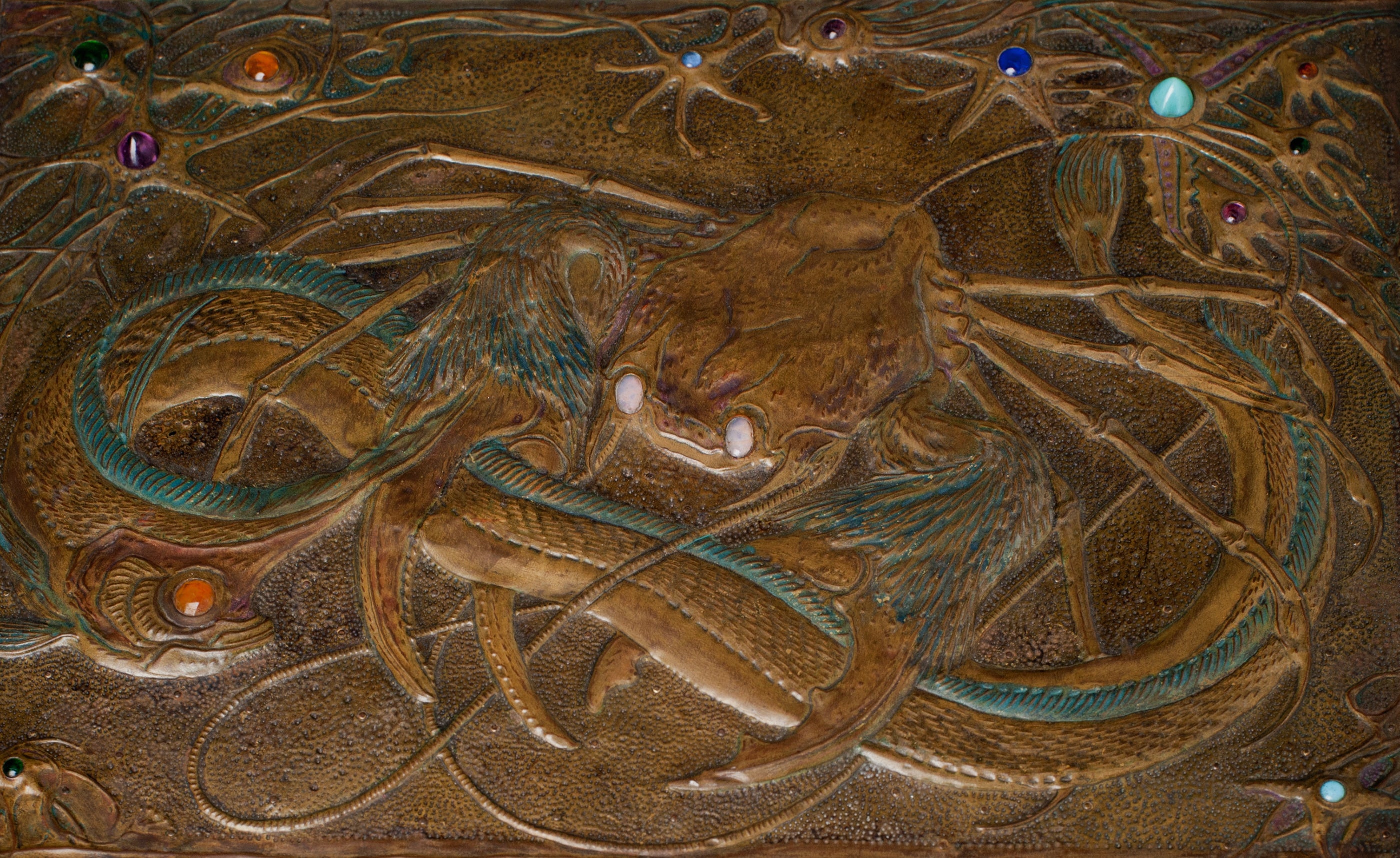
About the Seller
5.0
Gold Seller
Premium sellers maintaining a 4.3+ rating and 24-hour response times
Established in 2013
1stDibs seller since 2016
99 sales on 1stDibs
Typical response time: 6 hours
- ShippingRetrieving quote...Shipping from: Chicago, IL
- Return Policy
Authenticity Guarantee
In the unlikely event there’s an issue with an item’s authenticity, contact us within 1 year for a full refund. DetailsMoney-Back Guarantee
If your item is not as described, is damaged in transit, or does not arrive, contact us within 7 days for a full refund. Details24-Hour Cancellation
You have a 24-hour grace period in which to reconsider your purchase, with no questions asked.Vetted Professional Sellers
Our world-class sellers must adhere to strict standards for service and quality, maintaining the integrity of our listings.Price-Match Guarantee
If you find that a seller listed the same item for a lower price elsewhere, we’ll match it.Trusted Global Delivery
Our best-in-class carrier network provides specialized shipping options worldwide, including custom delivery.More From This Seller
View AllH.O. Miethke Das Werk folio "Water Snakes II" collotype print
By Gustav Klimt & K.K. Hof-und Staatsdruckerei
Located in Chicago, IL
Water Snakes II, no. 9 from the fourth installment of Das Werk Gustav Klimts
The last painting Klimt exhibited with the Secession before resigning, Water ...
Category
Early 1900s Vienna Secession Figurative Prints
Materials
Paper
H.O. Miethke Das Werk folio "Danaë" collotype print
By Gustav Klimt & K.K. Hof-und Staatsdruckerei
Located in Chicago, IL
Danaë, no. 2 from the fourth installment of Das Werk Gustav Klimts
Danae originates from Greek mythology. She is the daughter of the King of Argos. Because a...
Category
Early 1900s Vienna Secession Figurative Prints
Materials
Paper
H.O. Miethke Das Werk folio "The Hope II" collotype print
By Gustav Klimt & K.K. Hof-und Staatsdruckerei
Located in Chicago, IL
DAS WERK GUSTAV KLIMTS, a portfolio of 50 prints, ten of which are multicolor collotypes on chine colle paper laid down on hand-made heavy cream wove paper with deckled edges; under ...
Category
Early 1900s Vienna Secession Figurative Prints
Materials
Paper
H.O. Miethke Das Werk folio "The Three Ages of Woman" collotype print
By Gustav Klimt & K.K. Hof-und Staatsdruckerei
Located in Chicago, IL
DAS WERK GUSTAV KLIMTS, a portfolio of 50 prints, ten of which are multicolor collotypes on chine colle paper laid down on hand-made heavy cream wove paper with deckled edges; under ...
Category
Early 1900s Vienna Secession Figurative Prints
Materials
Paper
Max Eisler Eine Nachlese folio "Girlfriends II" collotype print
By (after) Gustav Klimt
Located in Chicago, IL
After Gustav Klimt, Max Eisler #1, Die Freundinnen II; multi-color collotype after 1916/17 painting in oil on canvas which was destroyed by fire in May 1945 at Immendorf Castle Lower Austria.
Eisler’s choice to begin his 1931 portfolio of works by Klimt with Girlfriends II was both bold and prescient. Just 14 years later, the painting was tragically destroyed in a fire. With such a loss, this rare and exquisite image is all the more valuable by virtue of having been made in color. In works from his late period, Klimt continued his fascination with exploring female dynamics and their various forms of love. Girlfriends II is a fine example of how space, color and ornament play a noticeable role in the evolution of his symbolic language. Wide swaths of space in the background as well as the two female forms create the structure. Klimt’s strong brushstrokes show a painterly quality and a new move toward abstraction which feels very far away from his earlier work. Nor should Klimt’s economy of line be overlooked. His draughtsmanship is what infuses the female bodies with movement, emotion and a profundity of life. Both women confront the viewer’s gaze unselfconsciously, as if they are modern-day Viennese women stepping out of a Klimtesque ukiyo-e print. Characteristic of this late period, Klimt uses ornament...
Category
1930s Vienna Secession Figurative Prints
Materials
Paper
H.O. Miethke Das Werk folio "Water Snakes I" collotype print
By Gustav Klimt & K.K. Hof-und Staatsdruckerei
Located in Chicago, IL
Water Snakes I, no. 9 from the first installment of Das Werk Gustav Klimts
Known by various names, Women Friends, Girlfriends, Water Snakes I and what Kli...
Category
Early 1900s Vienna Secession Figurative Prints
Materials
Paper
You May Also Like
Beethoven Frieze (detail) by Gustav Klimt, Das Werk collotype, 1908-1912
By Gustav Klimt
Located in Chicago, IL
Original collotype created from a detail of Gustav Klimt’s Beethoven Frieze. Published and edited by Verlag H.O. Miethke and printed by k.k. Hof- und Staatsdruckerei, Vienna, in an e...
Category
Early 1900s Vienna Secession Prints and Multiples
Materials
Paper
Death and Life by Gustav Klimt, Das Werk lifetime collotype, 1908-1912
By Gustav Klimt
Located in Chicago, IL
Original collotype created from Gustav Klimt’s Death and Life, painted in 1908. Published and edited by Verlag H.O. Miethke and printed by k.k. Hof- und St...
Category
Early 1900s Vienna Secession Prints and Multiples
Materials
Paper
Fulfilment-Metallic Poster. Printed in Austria
By Gustav Klimt
Located in Chesterfield, MI
Poster. Measures 16 x 11 inches and is Unframed. Good/Fair Condition-signs of wear consistent with age and handling (please see secondary images for details).
Category
Late 20th Century Portrait Prints
Materials
Lithograph
$140 Sale Price
20% Off
Expectation-Metallic Poster. Printed in Austria
By Gustav Klimt
Located in Chesterfield, MI
Poster. Measures 16 x 11 inches and is Unframed. Good/Fair Condition-signs of wear consistent with age and handling.
Category
Late 20th Century Portrait Prints
Materials
Lithograph
$140 Sale Price
20% Off
Portrait of Friederike Maria Beer, Gustav Klimt An Aftermath collotype, 1931
By (after) Gustav Klimt
Located in Chicago, IL
Original 1931 collotype created from Gustav Kilmt’s Portrait of Friederike Maria Beer, oil on canvas, 1916. Published by Max Eisler and printed by Österreichischer Staatsdruckerei (Austrian State Printing Office), Vienna, in an edition of 500.
In 1931, Max Eisler published the most notable posthumous collection of Gustav Klimt works to date. Using a complex gravure process, Klimt’s original oil paintings were painstakingly reproduced as collotypes on a handmade, deckled-edge cream wove paper. This world-class example of collotype captures the superb resolution and color-richness and ornamentation of the original 1916 oil painting.
"Friederike-Maria suggested that Klimt should paint her in a Viennese Workshop dress; she wore these exclusively. She was also very proud of a fur coat she owned, particularly during the hardship of the First World War, and Klimt decided that she should wear the coat too, but inside out, so that the decorative lining, also by the Viennese Workshop, was visible.
Klimt decided to make use of an imaginary oriental screen...
Category
1930s Vienna Secession Prints and Multiples
Materials
Paper
Schloss Kammer Lake Attersee II by Gustav Klimt, Das Werk collotype, 1908-1912
By Gustav Klimt
Located in Chicago, IL
Original collotype created from Gustav Klimt’s Schloss Kammer on Lake Attersee II (Das Werk Gustav Klimts), originally painted in 1909. Publishe...
Category
Early 1900s Vienna Secession Prints and Multiples
Materials
Paper
More Ways To Browse
Antique Paper Embosser
Marc Chagall Etchings Signed
Marc Chagall Green Horse
Marc Chagall Lithos
Marc Chagall Pencil Signed
Marc Chagall Set 12 Tribes Of Israel
Marc Chagall Stained Glass
Marc Chagall The Violinist
Marcel Schellekens
Margaret Burroughs
Mary Cassatt Drypoint
Maurice Cohen
Medieval Woodcut
Mein Leben Chagall
Mermaid Etching
Michel Pellus
Moonwalk Warhol
Morisot Etching
